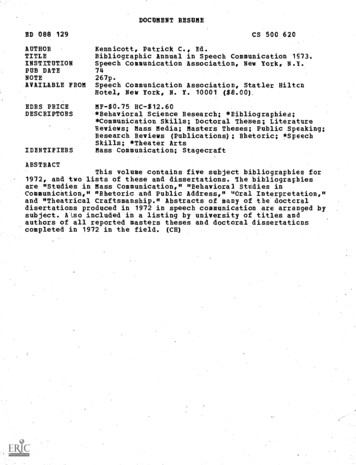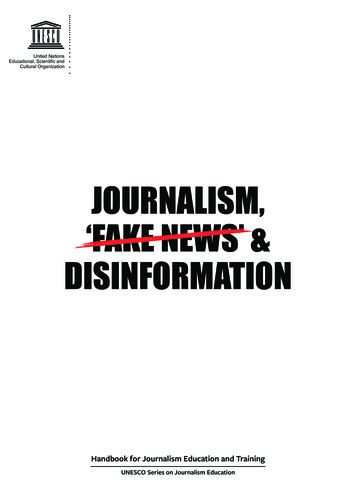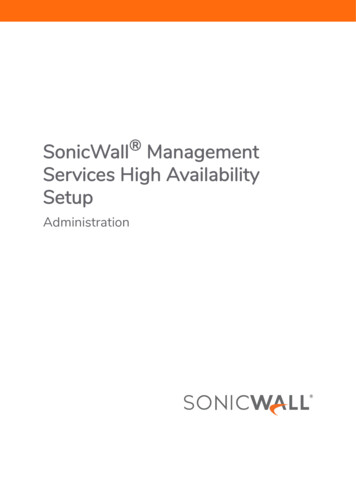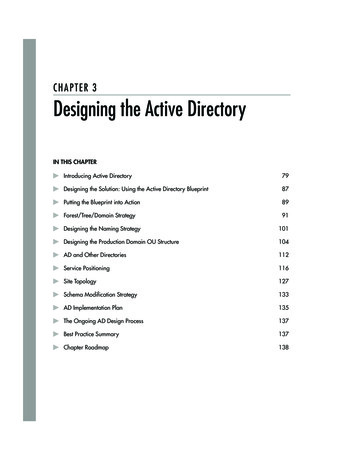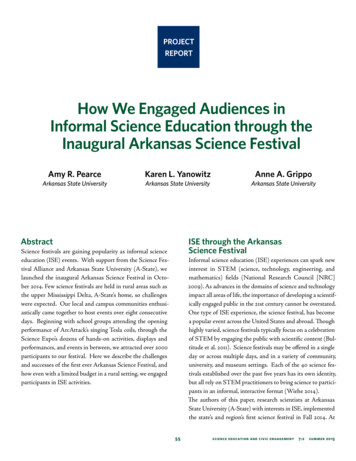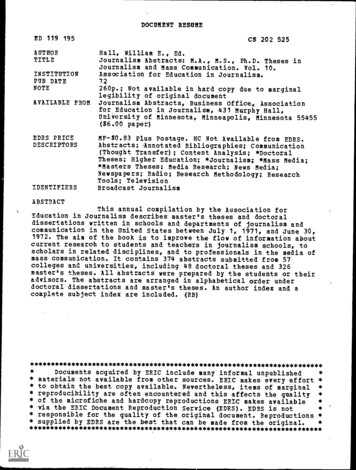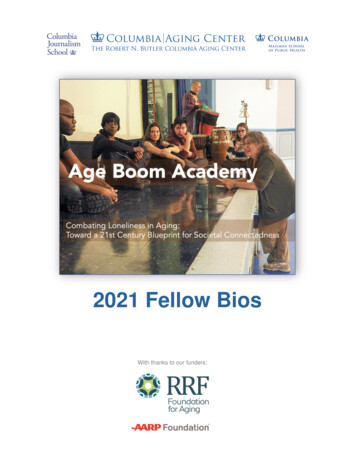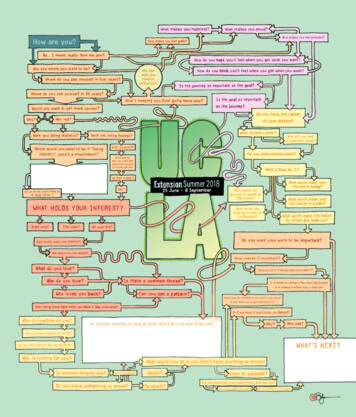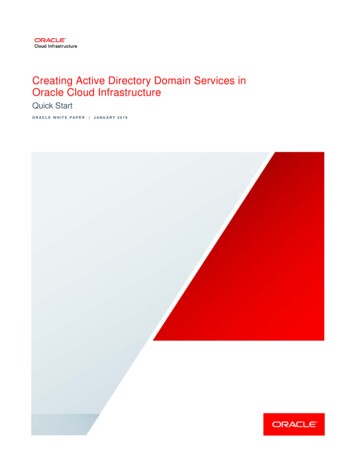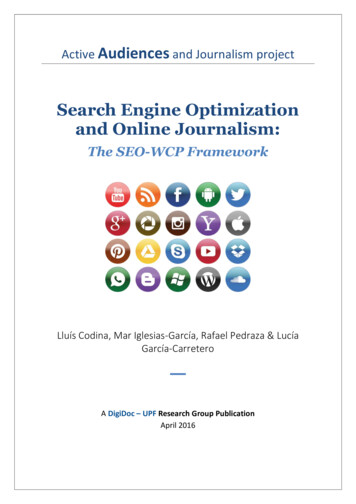
Transcription
Active Audiences and Journalism projectSearch Engine Optimizationand Online Journalism:The SEO-WCP FrameworkLluís Codina, Mar Iglesias-García, Rafael Pedraza & LucíaGarcía-Carretero A DigiDoc – UPF Research Group PublicationApril 2016
DigiDoc Research GroupUPFRoc Boronat, 138, office 53.80208018 Barcelonawww.upf.edu/digidoc/Contact: telephone 34 93 5421212 rafael.pedraza@upf.eduCC Lluís Codina, Mar Iglesias-García, Rafael Pedraza, Lucía García-Carretero.April 2016Covert picture: -social-1177293/Recommended format for citationCodina, Lluís; Iglesias-García, Mar; Pedraza, Rafael; García-Carretero, Lucía. Search EngineOptimization and Online Journalism: The SEO-WCP Framework. Barcelona: UPF.Communication Department. Serie Editorial DigiDoc, 2016Work distributed under CC licenceSerie Editorial DigiDocA deliverable in the Active Audiences and Journalism collectionCSO2012-39518-C04-02. National R&D i Plan.NS PAA04/2016A production ofWith the support of
Executive summaryThe dissemination of news stories today takes place via various platforms, among whichnews media websites are just one. In other words, the audience for journalistic content, thatis, those people who wish to be informed about the world around them, access news storiesvia the results pages of search engines as well as via social networks, and not solely via thewebsites of the news media.This means the news media today have to implement an effective search engineoptimization (SEO) policy to ensure their success, otherwise, these platforms (the resultspage and social networks) will not provide the percentage of visibility and visits that theseonline news sites should be obtaining.This document presents a framework for optimizing journalistic content, both from theperspective of web optimization or SEO and from the perspective of visibility on socialnetworks. The framework can be characterized as being: A methodology for training and for the acquisition of skills in the field of SEO andCommunication.A proposal for independent work, but one that is at the same time adaptable andcompatible with the style books of different news media.A proposal for new cyber media that need to adopt a methodology to begin theirprofessional activities.A proposal for comparing standards and procedures that any researcher or firm canadopt as part of their comparative analyses and benchmarking studies to improveprocedures.
About the authorsLluís Codina is an Associate Professor at the Pompeu Fabra University (UPF) in Barcelona. Heteaches in the Faculty of Communication on the undergraduate courses in Journalism andAudiovisual Communication. He is the coordinator of the UPF Master’s in SocialCommunication in the Department of Communication. He also forms part of the academicstaff that teaches on the Online Master’s in Digital Documentation and Search Enginesorganized by the UPF’s Institute of Continuing Education. He is an associate member of theDigital Documentation and Interactive Communication (DigiDoc) Research Group andcoordinator of its Research Seminars. ORCID: http://orcid.org/0000-0001-7020-1631Contact: lluis.codina@upf.eduMar Iglesias-García is a journalist and lecturer in the Department of Communication andSocial Psychology at the University of Alicante. She teaches on the undergraduate course inAdvertising and Public Relations and on the course in Tourism. She also participates in theresearch project entitled “Active audiences and journalism. Interactivity, web integrationand searchability of journalistic information”, funded by the Ministry of Economy andCompetitiveness. Since 2010, she has been the director of the cyber newspaperComunic@ndoUA. ORCID: http://orcid.org/0000-0001-7926-5746 Contact:mar.iglesias@gcloud.ua.esRafael Pedraza-Jiménez is an Associate Professor in the Department of Communication atthe Pompeu Fabra University (UPF). He teaches on the undergraduate courses in Journalismand Audiovisual Communication. He also teaches on various masters’ and postgraduatecourses at the UPF and at other universities. As a researcher, he coordinates the DigiDocResearch Group. Throughout his career, he has participated and/or led a number of publicand private research projects. Based on these research findings, he has published severalbooks and articles in journals of international impact. ORCID: http://orcid.org/0000-00026918-6910 Contact: rafael.pedraza@upf.eduLucía García-Carretero is a journalism graduate from the University of Valladolid and theholder of a Master’s in Social Communication from the Pompeu Fabra University (UPF). Asthe recipient of a research grant, she forms part of the Teaching and Research Staff at theUPF. She is a member of the Journalism Research Group and the Digital Documentation andInteractive Communication (DigiDoc) Research Group. Her research interests lie in the studyof online political communication and the analysis of electoral communication strategies indigital networks. ORCID: http://orcid.org/0000-0002-1414-3921 Contact:lucia.garcia@upf.edu
PrefaceSerie Editorial DigiDocThis series reports the direct findings of a number of research projects. Indirect findings aretypically published in refereed journal articles, but given their length, there is usuallyinsufficient room for direct findings. After several years these results might appear inmonograph form or simply lie forgotten in a drawer. Current trends in academic policyfavour an open-access approach, whereby researchers are encouraged to make their resultsas widely available as possible, for example under Creative Commons licences, and whereappropriate in institutional repositories or in the research group’s own repository. In keepingwith this philosophy, we present this Serie Editorial and other forms of open-accessdissemination that our group has adopted as part of the journal, Anuario Hipertext.net.Active Audiences deliverablesThe Active Audiences Project is concerned with the analysis of various aspects of the cybermedia. The different activities that make up this project – “Active audiences and journalism.Interactivity, web integration and findability of journalistic information”, funded by theNational R&D i Plan, have generated results that have been published in indexed journalsand presented at various conferences. However, they have also generated direct results. Thedissemination of these direct results, in all cases related closely to our research objectives, isachieved via this collection of Deliverables, in keeping with open-access recommendationsand guidelines regarding the need to make direct research results available too. This presentdeliverable corresponds to one of our secondary research lines, namely our focus on SEOand Communication.
Search Engine Optimization andOnline Journalism:The SEO-WCP FrameworkBy Lluís Codina (UPF), Mar Iglesias-García (UA), Rafael Pedraza (UPF) & Lucía GarcíaCarretero (UPF)A framework is a standardized set of concepts, practices, and criteria for dealing with a common type ofproblem, which can be used as a reference to help address and resolve new problems of a similar nature(Wikipedia)0. Understanding this FrameworkAs the opening quotation above indicates, we understand that a framework should be ableto provide both concepts and criteria. Here, in the case that concerns us, we would add thata framework should also provide a basic premise and a statement of its objectives and itsoverall scope.The structure of the SEO-WCP Framework that we propose here is best summed up,therefore, in the following table:Nº stificationTo establish the objectives of the framework and its overall scope,based on the methodology adopted, as well as to outline theprincipal sources drawn upon.To acknowledge a clear preference for the primacy of journalisticcriteria over those of SEO in cases of incompatibility. To identify thedifferent stages in the procedure. To provide a justification for thename given to the framework. To establishing a taxonomy of thedifferences between SEO and Journalism.To support and aid interpretation of the procedure with proposalsfor definitions of OnPage factors, including keywords and relatedconcepts.The most characteristic features of the framework, namely, therecommended procedures and criteria.
1. Objectives, scope and sourcesOur aim in the sections that follow is to propose a framework for optimizing journalisticcontent from two perspectives: that of search engine optimization (SEO), on the one hand,and that of visibility on social networks, on the other.However, we ought to clarify from the outset that it is not our aim to provide a descriptiveproposal, that is, we do not seek to describe how to optimize de facto the journalisticcontent of media sites in relation to SEO.Indeed, we do not know exactly how they do it. A descriptive analysis of this kind wouldrequire, if it were to be attempted, a specific study of at least one media group and, eventhen, we do not know if the disclosure of this strategic information by the news media ispossible. In any case, this is not something we seek to undertake at this stage in our work.However, whatever it is they do, what we do know is that it probably involves a variation ofthe framework that we present here.We understand, therefore, that our framework is at the same time both possible andplausible as it is consistent and fully concurs with the tutorials and recommendationsemanating from the best practices of so-called white hat SEO (including those of Googleitself) as well with those originating from organizations linked to SEO as applied to the worldof journalism, among which we should highlight the News University of the Poynter Institute(in this case via its webinars) and the BBC Academy, especially as regards such elements asthe double headline system employed in this framework.Our proposal is, therefore, independent of any specific news media site and, moreover, it iswe believe compatible with the different writing styles of all the news media.Our framework also draws on the two-stage optimization system, comprising writing checking, developed by the producers of what is currently the most prestigious optimizationsoftware, YOAST SEO, one of whose extensions includes a plugin for optimizing news storiesfor Google News, which is also taken into consideration here.We have also drawn on the reports of some of the leading SEO analysis companies, mostnotably those of Moz and Searchmetrics, as well as the results published in one of thechapters of the PhD thesis written by Dr. Carlos Gonzalo, supervised by one of the designersof the present framework. This study undertakes a systematic analysis of the more than 200web positioning factors that Google uses and will form the basis of a forthcoming publicationin the DigiDoc Series.In addition, we have conducted an exhaustive review of recent publications on SEO factorsas well as of the (few) academic publications that link SEO and Journalism, most notably the
contributions of Giomelakis and Veglis (2015, 2016). All these references can be found in thebibliography at the end of this paper.Finally, the framework proposed here has benefited from a series of seminars and meetingsinvolving SEO and Communication experts organized as part of the Active Audiences project.All other sources drawn upon are included in the bibliography.At the outset we stressed that our proposed framework does NOT constitute a descriptionof how the media, de facto, go about optimizing their content for search engines. We shouldnow, therefore, identify the purposes we believe it can serve: A methodology for training and for the acquisition of skills in the field of SEO andCommunication.A proposal for independent work, but one that is at the same time adaptable andcompatible with the style books of different news media.A proposal for new cyber media that need to adopt a methodology to begin theirprofessional activities.A useful proposal for comparing standards and procedures that any researcher orfirm can adopt as part of their studies to improve their procedures.2. Premise and naming of the frameworkIn this section we explain our working premise and the name chosen for the framework, theWCP Framework, given that the two concepts are related.The initials that make up the name correspond to the three recommended phases of theoptimization procedure:[WRITE] [CHECK] [PUBLISH]2.1.PremisesThese three phases correspond to the principal premises of our framework, where they arerelated to the concepts of Writing the news story and SEO check . Thus we argue thatthat: the writing of the news story must adhere to the principles of journalistic style;the SEO check, as is logical, must adhere to criteria of search engine visibility andvisibility on social networks;all possible contradictions must be resolved in favour of journalistic criteria (hencethe primacy of journalistic principles);
once the news story has been written in accordance with the principles of journalismand the story has been optimized for search engines (and all contradictions havebeen resolved), it can be published or disseminated via various platforms orchannels.The following diagram illustrates the dual nature of these premises phases, which we labelwith the initials WCPFigure 1: Diagram of the premises and the order of the phases in the WCP Framework2.2.TaxonomyAn initial taxonomy of the reasons for the differences between the journalistic principlesand those of SEO principles points to two main elements, namely, Context and Divergences.In keeping with these, the reasons for the need for different news headlines and SEO titlescan be identified as follows. Thus, as regards the headline we need to recognise: Context of the news story:o As part of the cyber media webo As part of the search engine results page (SERP)o As part of a social network wall or timelineDivergenceso Section and explicit headline vs Webpage contexto Explicit components vs Webpage contexto Surnames vs Full nameso Style guide recommendations vs Search trends
The above taxonomy can be interpreted as follows: as far as the context is concerned, this isvery different if we consider the news story in the context of its webpage, where it willappear under a clearly identified section, as opposed to in isolation as part of the wall of aFacebook page or a Twitter account timeline.In turn, these differences of context give rise to the need to include the name of the sectionin which the news story appears within the SEO title (in the metadata title ), somethingthat is not necessary in the news site headline ( h1 tag); the same occurs with the need touse full names (name and surname) in the metadata ( title ), but not in the news siteheadline ( h1 ), etc.Having drawn these distinctions, in the following sections we present the differentcomponent parts, beginning with some conceptual elements.3. ConceptsWe divide the concepts in three parts: the double headline principle, platforms andkeywords. We examine each of these below.3.1.Double headline principleThis principle is closely linked to the premises (2.1) and to the taxonomy of reasonsaccounting for the divergences (2.2.). The principle informs us that thanks to the use ofmetadata the journalistic criteria and the SEO positioning criteria are compatible.The double headline refers to the possibility/opportunity of using a news headline on themedia site’s webpage with the h1 tag in HTML – which fulfils the aforementionedjournalistic criteria – and an SEO title modified in part using the metadata title – whichfulfils the SEO criteria.For example, a good working rule in cyber media is that the SEO title should always includethe media brand name and the section title – two useful data for SEO, but unnecessary aspart of the headline (h1) from the point of view of journalistic criteria.This principle can be extended to the various distribution platforms of journalistic content,typically such digital networks as Facebook and Twitter.3.2.PlatformsThe webpage of a cyber media site is the natural place for the publication of its news stories.However, just because it is the “natural” place does not mean that the site’s webpage is theplace where the news story will be seen for the first time nor where it will be read mostfrequently.
Indeed, we understand that today a news story or journalistic report is likely to be seen forthe first time on at least one the following platforms, and which for the purposes of ourframework can be considered the most important: Search Engine Results Page (SERP), where the news story will appear as a snippet inwhich the headline will be taken from the metadata title (not from the content ofthe h1 tag) and in which the description of the other metadata is also available. Facebook Twitter Webpage of a cyber media site3.3.SEO factors and keywordsThe different elements that have a positive or negative influence on the visibility andpositioning of website, and therefore, of a news story, are referred to as the SEO factors.These factors may be fully controlled by the author of the page, when they are known asOnPage factors, or they may lie (partially) beyond the author’s control, when they areknown as OffPage factors.The main concern of OnPage optimization is the actual webpage content and here thekeywords play a decisive role. Thus, in presenting our framework we begin by consideringvarious aspects related to the vital concept of the keyword.The point of view we adopt and the criteria on which we base our definition of keywords isjournalistic, that is, the perspective corresponding to the newsroom or the journalist/authorof the news story.SEO factors - OnPage and OffPageThe features or properties of a page that help (or hinder) a site’s search enginepositioning are known as SEO factors. These factors are divided into OnPage andOffPage factors. The former are those over which the creator of the page (in ourcase, the writer of the news story) has total control, as they are concerned with thepage’s content. The latter lie (largely) beyond the control of the page’s creator, asthey are concerned with inbound links received from other websites and frommentions on social networks by social actors. The framework presented here focusesexclusively on the OnPage factors.
KeywordThis is the term we hope will be used in searching for the news story or the small setof words which we hope will make the news story visible following a Google search.Normally, we optimize a story for one keyword. If we want to optimize the story fortwo or more words, then we must repeat the checks presented below and considermaking the news story longer.Keyword densityThis is the number of times the keyword appears in relation to the total number ofwords contained in the news story. It is calculated by dividing the number of timesthe keyword appears by the total number of words and multiplying by a hundred.For example, if the keyword is used 10 times in a story that is 500 words long, thenthe density is 2 per cent.Optimum keyword densityIs there an optimum density? Officially, Google says there is not. The officialrecommendation is that an article should be written for humans, not for Google, sothat the best density is that which occurs spontaneously when using naturallanguage. However, although there is no optimum density, a number of expertanalyses clearly point to the existence of an optimum range as discussed below.Under-optimizationHuman beings are not always rational. We might write a long article under theimpression that we have been expressing our ideas on a given topic, but in facthardly use the keyword that best identifies that topic. In this case, the low keyworddensity will prevent Google from considering the news story relevant, leading to acase of search engine under-optimization, which is as unwelcome as overoptimization.
Over-optimizationGoogle’s analytic algorithms penalize over-optimization – that is, the unnaturalrepetition of the same word or phrase in a given text, above and beyond the usualfrequency for a language. Good writing uses a combination of synonyms andexpressly avoids repeating the same word too often in the same sentence. Thisnatural quality of writing is what Google seeks to promote by penalizing texts overoptimized for search engines.Optimum rangeWhile it seems that there is no optimum density, there does appear to be anoptimum range, which provides a clear indication of the minimum and maximumdesirable densities. The minimum and maximum densities should be avoided so asnot to run the risk of under-/over-optimization, respectively. According to variousanalyses, it seems that the optimum range is relatively wide, extending between 0.5and 2.5 per cent, at least in the case of relatively long texts (300 words or more).Optimum distributionMany SEO professionals prefer to think in terms of an optimum distribution ratherthan of an optimum density. Hence, what is valued is where the keyword appears(i.e., in which parts of the page) and not how many times it actually appears. As longas the optimum range is respected, the idea of distribution is more efficient becauseit allows us to present a cogent entry structure, without abusing the naturallanguage.Latent Semantic IndexingThis expression originates from the theory of information retrieval, which searchengines, in part, draw upon to “understand” the topic of a page. According to thistheory, to know if a page matches with a certain keyword, the synonyms and relatedterms of that particular word must also be considered. For example, to know if apage matches a search that uses the term “human rights”, the search engine willdeem pages to be more relevant if in addition to this term they also contain suchwords as “democracy”, “freedom”, “justice”, etc.
EntitiesIndividuals, organizations, cities, businesses, etc., constitute what are known asentities in semantic searches. More specifically, in the domain of the websites werefer of course to the actual names of entities. The appearance of such names and,therefore, the appearance of proper names, place names, etc., lends credibility to anews story, because it can be interpreted both as a reference to current newsworthyevents as well as to possible sources.Thus, entities constitute another way of addressing the concerns of the keywordsthat should appear in a news story.
4. ProceduresLet us stress from the outset that some of the above concepts can result in the need to editor rewrite sections of the news story. These steps should always be taken, unless they affectthe journalistic quality.In the case of contradictions between the SEO imperative and the journalistic imperative,those of search engine optimization should always give way. Journalism is at the service ofpeople, not of Google. For example, as we shall see below, checkpoint 1 proposes aminimum news story length of 300 words, but this should only be applied when it does notrun counter to the specific journalistic genre.That said, the points that the journalist/author should consider under this framework are:01. Length. At least 300 words, although it is much better if the news story exceeds thisword count.02. Multimedia. Always incorporate an element of multimedia, at least a photograph1.03. Keyword. Decide what the main keyword of the entry is.04. Optimum distribution of the keywordi.ii.iii.iv.v.vi.vii.viii.ix.x.In the main heading or the news headline (h1 tag)In the URL of the entry. Edit the URL if necessary to avoid empty words and tolimit length. Short, readily handled titles are preferable.In the SEO title, via the title tag. Maximum 70 charactersIn the metadata in the description of the meta tag. Maximum 156 charactersIn one of the headings in the body of the news story (h2 tag)In the first paragraphIn one or more of the central paragraphsIn one or more of the final paragraphsIn one of the images.In some of the external hyperlinks to related sources05. Emphasis. In some of its occurrences, the keyword should he highlighted in bold oritalics.1One aspect that is sometimes not given the importance it should be given, and that can be influential, is theoptimization of images with the appropriate use of tags; that is, adding a term to the image name in order that search enginescan find it. The term should describe the image content and include a keyword so that it can be readily found by users.Additionally, the weight of the image needs to be taken into account, because if it is of high quality and heavy, thedownloading speed of the webpage decreases, and search engines penalize sites that take too long to download theirelements (Iglesias-García & Codina, 2016).
06. Internal navigation. If possible, the keyword should be linked to a category or internaltag.07. Semantic support. Use synonyms of the keyword and related terms in the body and/orin the headings of the entry to strengthen the keyword.08. Credibility. Mention entities in the form of the name of persons, places and institutions,and add links to the entities where appropriate.09. Internal links. Wherever possible, establish links with other thematically related entries,using the website’s taxonomy or system of tags or categories.10. Social web and adaptive content. Be sure to configure the entry so that it is publishedon the social networks, and that there are buttons of diffusion in activated andconfigured social networks. If the CMS so allows, consider titles, descriptions and specificimages for networks such as Facebook and Twitter.11. Programming. Program the entry, if appropriate, so that it is published at the optimumtime in relation to its content and nature.5. ConclusionsThe framework presented here comprises a working combination of premises, concepts andprocedures. It is not based on the analysis of how the processes of de facto news mediaoptimization should be carried out, but rather on how it is plausible and at the same timefeasible to consider the way in which these processes can be undertaken based on the bestevidence available and on the best practices known.The framework should be useful, not only as a tool for training and the acquisition of skills,but also as a starting point for new cyber media sites that need just such a spring board tooptimize their journalistic content in terms of web visibility and SEO.It should also serve as a starting point for comparative analyses and benchmarking studiesfor SEO and communication, since it offers a series of points that lend themselves tocomparative study.6. BibliographyASSER, Martin. 2012. "Search Engine Optimisation in BBC News". WebLog. Available h engine optimisation in Consultedon 01.04.2015.BARRY, Chris & LARDNER, Mark. 2011. "A Study of First Click Behaviour and User Interactionon the Google SERP". Information Systems Development. 89-99. Available 4419-9790-6 7 Consulted on
01.04.2015.CODINA, Lluís. 2004. "Posicionamiento web: conceptos y ciclo de vida". AnuarioHipertext.net. Available at: http://www.upf.edu/hipertextnet/numero2/posicion web.html Consulted on 03.04.2015.CODINA, Lluís. 2014a. Publicación digital y SEO para comunicadores. Available seo-comunicadores Consulted on01.04.2015.CODINA, Lluís. 2014b El SEO ha muerto, ¡viva el (nuevo) SEO! Optimizar la visibilidad decontenidos periodísticos. Available at: http://www.lluiscodina.com/nuevoseoConsulted on 01.04.2015.CODINA, Lluís & MARCOS, Mari Carmen. 2005. “Posicionamiento web: conceptos yherramientas”. El profesional de la información. Vol. 14. Nº2: 84-99.CHITIKA ONLINE ADVERTISING NETWORK. 2013. "The Value of Google Result Positioning".Online Advertising Network. Available at: ed on 12.04.2015.DICK, Murray. 2011. "Search engine optimisation in UK news production". JournalismPractice, vol. 5. Nº 4: 462-477.DUTTON, William & BLANK, Grant. 2011. "Next generation users: the internet in Britain.Oxford Internet Survey 2011 report. Oxford Internet Institute, University of Oxford.Available at: http://www.oii.ox.ac.uk/news/?id 598 Consulted on 11.04.2015.ELLIS, Justin. (2011). "Traffic Report: Why pageviews and engagement are up atLatimes.com". NiemanLab. Available at: -pageviews-and-engagement-are-up-at-latimes-com Consulted on12.04.2015.EISENBERG, Bryan; QUARTO-VONTIVADAR, John; DAVIS, Tomas & CROSBY, B. 2008. Alwaysbe testing: the complete guide to Google website optimizer. Sybex, Indianapolis (US).FREIXA, Pere; SORA, Carles; SOLER-ADILLON, Joan & RIBAS, J. Ignaci. 2014. "Snow Fall and AShort History of the Highrise: two approaches to interactive communication design byThe New York Times". Textual & Visual Media. Nº7: 63-84GIOMELAKIS, Dimitrios & VEGLIS, Andreas. 2015. "Employing Search Engine OptimizationTechniques in Online News". Studies in Media and Communication, Vol.3. Nº1: 22-33.GIOMELAKIS, Dimitrios & VEGLIS, Andreas. 2016. “Investigating Search Engine OptimizationFactors in Media Websites”. Digital Journalism, 4:3, 379-400, DOI:10.1080/21670811.2015.1046992
GONZALO, Carlos; CODINA, Lluís & ROVIRA, Cristòfol. 2015. "Recuperación de Informacióncentrada en el usuario y SEO: categorización y determinación de las intenciones debúsqueda en la Web". Index Comunicación Vol.5. Nº3: 19-27. Available php/indexcomunicacion/article/view/197 Consulted on 05.04.2015.GRAVES, Lucas & KELLY, John. 2010. "Confusion online: Faulty metrics & the future of digitaljournalism". Columbia University. Graduate School of Journalism. New York (US).Available at: http://www.journalism.columbia.edu/page/633/437 Consulted on01.04.2015.HERRMANN, Steve. 2009. "Changing headlines". BBC Editors.
Search Engine Optimization and Online Journalism: The SEO-WCP Framework. Barcelona: UPF. Communication Department. Serie Editorial DigiDoc, 2016 Work distributed under CC licence Serie Editorial DigiDoc A deliverable in the Active Audiences and Journalism collection CSO2012-39518-C04-02. National R&

